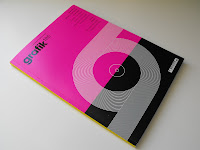


One thing that I've been considering is how to bring together the heritage that the British Library represents and more contemporary ideas. The building itself could already be perceived as not being sympathetic to the more historic aspects of the organization's activities, so I'm suggesting that I
don't have to develop something that has some "sentimental" appreciation of the past. However, we discussed in the group tutorial a while back how this product would work for two audiences: one that holds the belief that it captures the essence of the British Library and one that sees it more as a design-led curiosity.
One decision I've made is to ensure that externally it doesn't feel like it leans too strongly one way or the other. I really like the book cloth when used with strong typography and feel that it presents a good, but simple, fusion of modern and traditional. So the intention is to bind the package (as a book) with the cloth with some basic information presented in a strong, graphic way. The text will adhere to the British Library's brand guidelines.
Internally I want it to be more challenging and blend a number of different elements: the sound visualizations, the documentation of the environment, the grids based on the axonometric views, copy relating to the organization, etc. The above referenced images are to help illustrate another suggestion: the coming together of the traditional elements with the contemporary. The idea is that this kind of suggestion of the historic alongside obvious digital age additions is more than just a way of highlighting a visual tension between disparate elements. It actually represents a shorthand for the way that the organization works and would also be defining a style that is supposed to work on a cheekier, irreverent level in addition to it also being able to suggest a weightier, respectful approximation when read by a different audience.














































